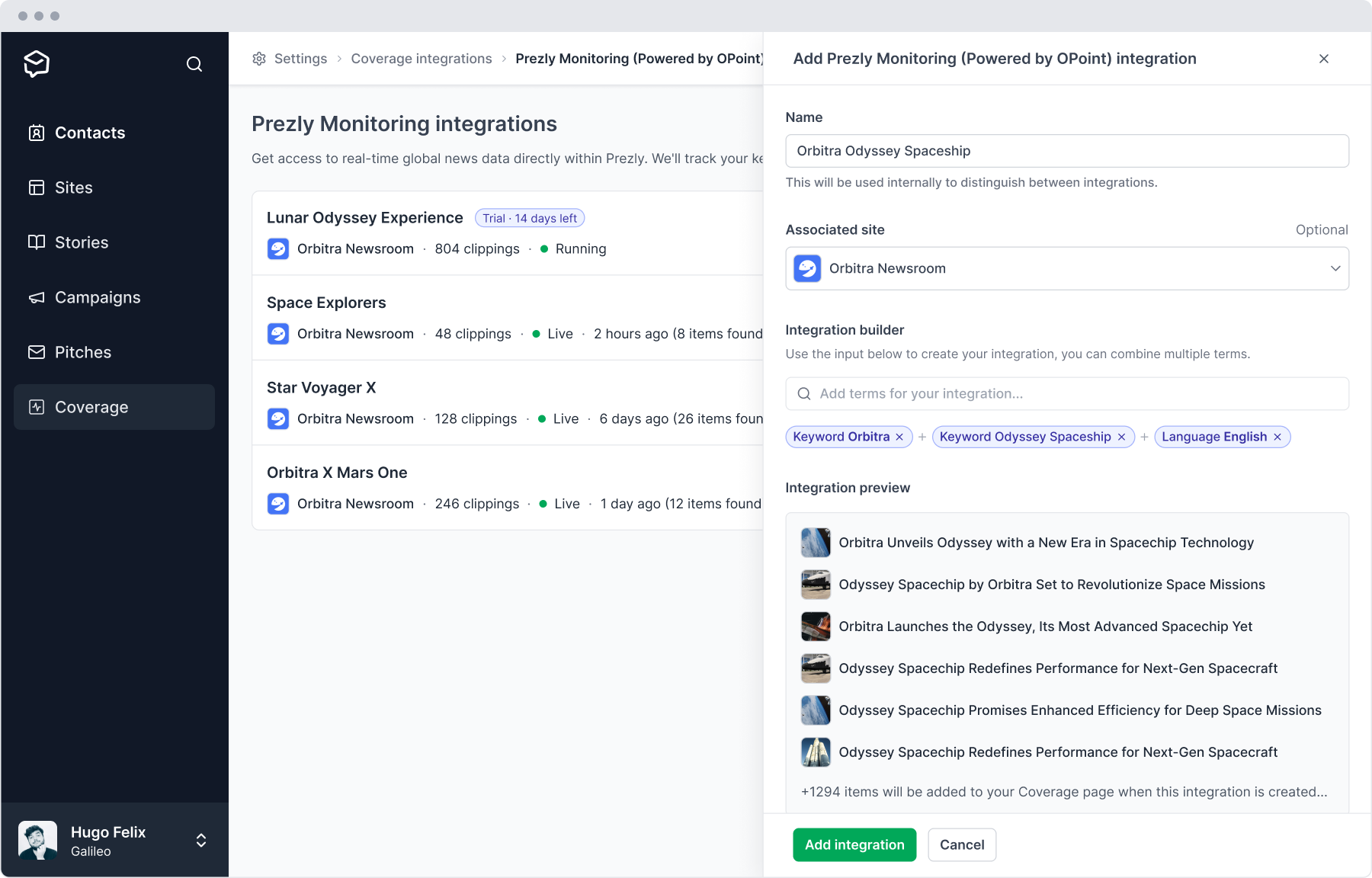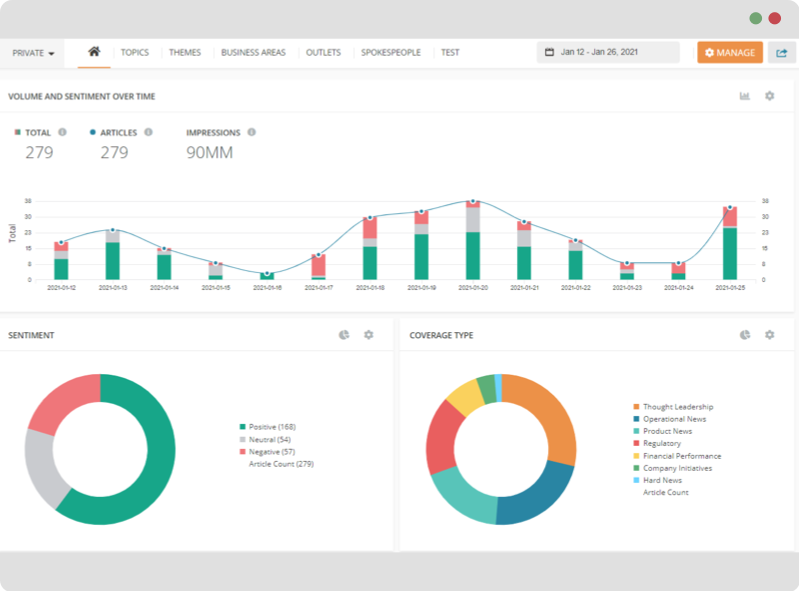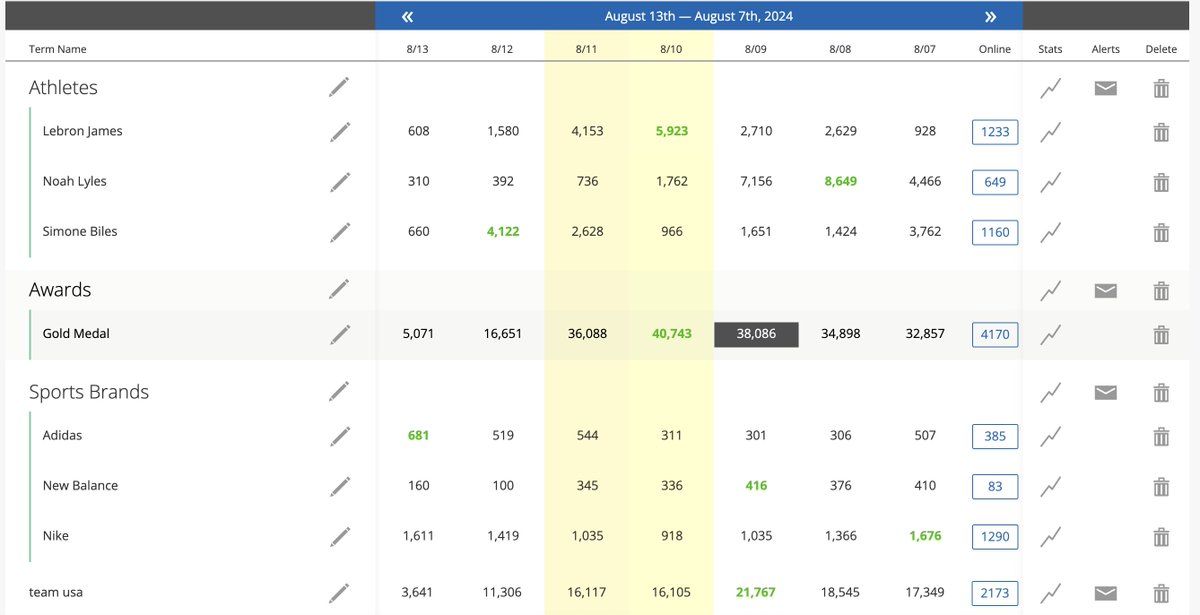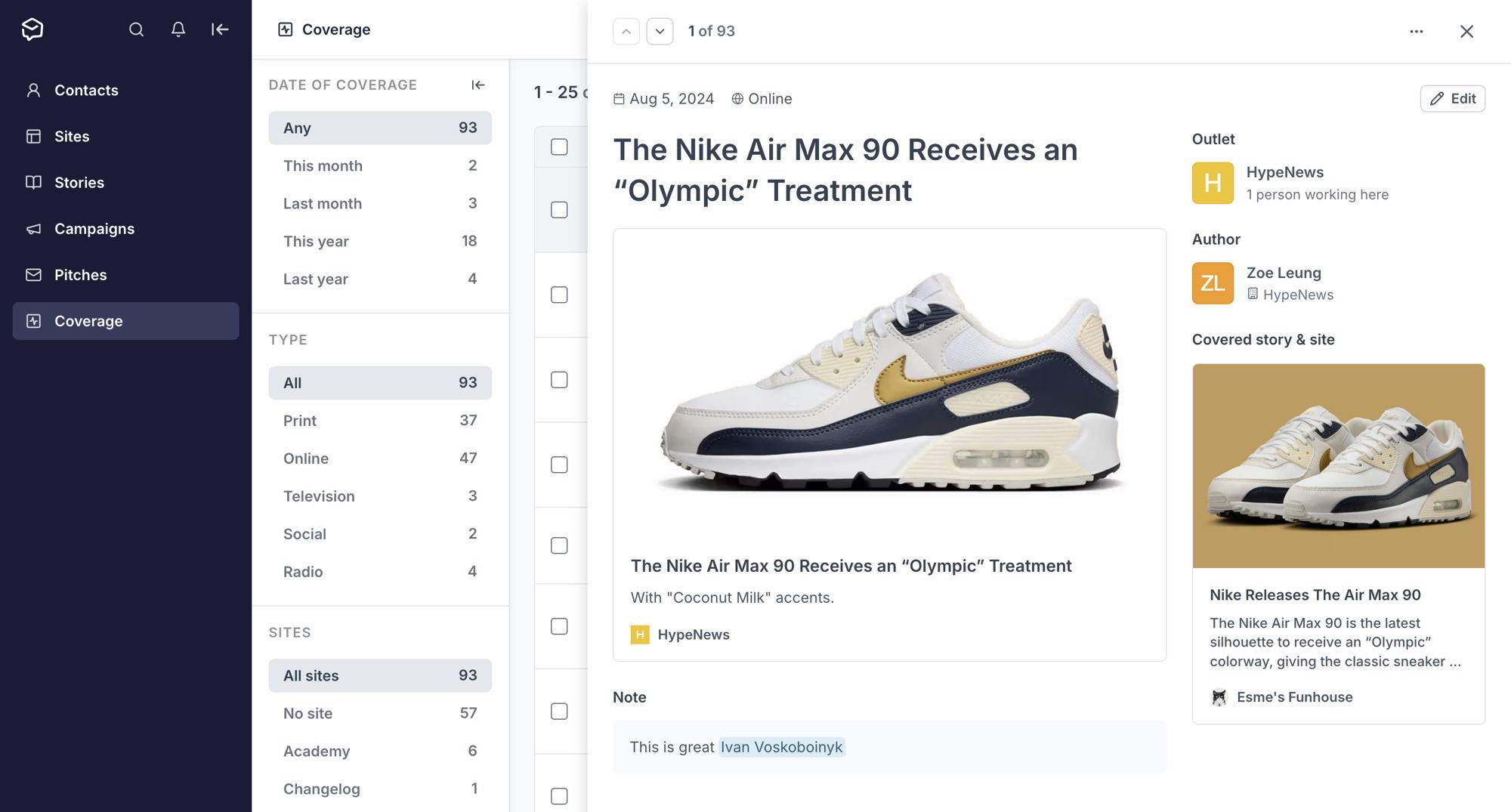Media monitoring: 6+ tools, benefits & more
Someone has to do some press monitoring, it might as well be you.
Ever wondered what people are really saying about your brand when you're not in the room?
Media monitoring offers more than just tracking mentions – it provides real-time insights into audience sentiment, emerging trends, and competitor strategies. These insights can transform your PR efforts, helping you adapt quickly, report on PR results, and stay ahead in a crowded industry.
In this article, we’ll dive into media monitoring solutions, explore the different types across communication channels, and highlight tools that deliver comprehensive sentiment analysis to give your brand a competitive edge.
Plus, there may be some gifs from The Office.
Try Prezly media monitoring free for 14 days
- Automatically track your news media coverage
- Understand who is talking about your brand
- Create email reports with embedded coverage

Media monitoring is tracking and analyzing content and public perception across various media. This includes online news articles, blogs, social media platforms, and broadcast channels. Organizations can gain valuable insights by evaluating this information. They can see their brand's reputation, spot trends on social channels, and measure their comms' effectiveness as an industry leader. The goal is to track public perception about a brand, its competitors, and industry trends / industry insights, all to help businesses make data-driven business decisions and spot potential crises.
While it sounds like a relatively simple concept, it's pretty intense and can get complicated fast. Why is this? Well, the internet is massive. And growing. And an unstoppable force. And terrifying.
There are an estimated 50 billion devices with internet access currently in use worldwide. There are 200,000,000 emails and 480,000 tweets sent every minute. The vast amount of data uploaded to the internet is absolutely and utterly mind-blowing. And getting granular insights on all of that? Yeah, it's not simple.
Better still, media monitoring isn't limited to just the internet. Offline media includes newspapers, broadcast television, and analogue books printed on honest-to-god pieces of paper.
Media monitoring can be categorized into five main types, each serving a distinct purpose:
This type involves tracking coverage in newspapers, magazines, and broadcast media. Organizations analyze this content to see how traditional media portray them. They want to gauge public sentiment and identify key influencers.
Social media monitoring tools track brand mentions on platforms like Twitter and Facebook. It lets organizations engage with their key audiences and manage their online reputation beyond their own social media accounts. They can also respond to inquiries, customer queries, and influential figures.
This type involves monitoring online news websites and blogs for a range of mentions of a brand, product, or relevant industry topics. Online news monitoring helps organizations stay informed about industry trends, content performance, and competitor activities.
Broadcast media monitoring focuses on tracking content from television and radio channels. Organizations use this type to evaluate their presence and reputation in audio-visual media. They also want to assess the impact of their communication efforts.
Influencer monitoring is tracking the activities of influential figures in a specific industry. It helps organizations spot collaboration opportunities. And, it gauges the impact of influencer marketing campaigns.
Media monitoring plays a crucial role in shaping an organization's strategy. By tracking brand mentions, industry trends, and competitors, businesses can manage their reputation. They can also make informed decisions. It lets organizations gauge public sentiment and spot potential crises so they can respond in the nick of time.
Media monitoring is helpful for gauging how your brand is doing with critics, fans, customers, and the general public. Monitoring used to be a lot more straightforward when we were just checking press coverage, like a newspaper running a story on a new branch opening.
With the explosion of different types of media in the last two decades as well as the current ubiquity of social media platforms and online discourse, "media monitoring" is no longer such a simple task.
But why even bother doing media or press monitoring at all? Here are five key benefits.
Media monitoring gives you real-time insights into how your brand is perceived by the public. That means you can assess your reputation by analyzing mentions on various platforms and adjust your strategies as needed. This ongoing check helps businesses keep a good image, and fix potential issues before they escalate.
- Get ahead of any potential scandals or PR crises
- Identify influencers to promote your product and PR thought leaders for potential collaborations
- See how the narrative around your brand is changing over time
- Track the efficacy of PR and marketing campaigns
- Find favorable company mentions for use in marketing and publicity
Top tip: You can also use it to monitor your competitors.
Keeping an eye on competitors is essential for staying ahead in any industry. Media monitoring lets you follow what your competitors are up to and how they’re viewed by the media and public. As well as being fun to snoop, this can help you spot opportunities for your own brand. Knowing how others in your field are doing is a great way to stay innovative and competitive.
Similar to tracking the competition, knowing what's going on in your field is crucial to staying relevant, and gives you the opportunity to weigh in on current affairs (and, dare I say, newsjack). Often we can get stuck in our lanes as far as working on our own products and projects, but what if the industry has shifted massively without you knowing? What if a scandal breaks out, and you didn't plan for it?
Staying on top of the industry means that you can sidestep a potentially embarrassing or even catastrophic situation, not to mention avoid appearing tone-deaf or unaware.
You and I both know that your product is literally perfect. That's not even a question. However, there's always room for improvement on perfection.
Media monitoring provides valuable feedback from customers and stakeholders. By utilizing customer feedback tools to analyze social networks and check things like comments, review sites, positive reviews, and online discussions, organizations can improve their products.
This loop lets businesses use data to improve their offerings based on customer preferences and basically stay relevant.
It can also help foster high-quality customer interactions, leading to better customer care and therefore more positive customer testimonials.
There are numerous examples of companies that failed to innovate and who were overtaken by competitors. The moral of the story is: if your customers or fans care enough to say something about your brand, listen to them.
We all know that engaging with your target audience is essential for building brand loyalty. Media monitoring helps organizations spot industry trends and customer sentiment, and enables quick and effective responses. By joining discussions and addressing concerns, businesses can build better audience relationships.
People love it when brands manage to toe the line of being cheeky and engaged on social networks. You can certainly do this badly and run the risk of offending and alienating people, but good social media listening and customer engagement can provide tons of free publicity.
Here's an example.
A woman on TikTok shared a wild recipe for macaroni and cheese. In it, she added raisins and everyone in the comments was not having it. Famed raisin brand Sunmaid got into the mix to condemn the travesty. And the result? 86,400+ "likes" and countless profile views for, and I cannot stress this enough, raisins. Tons of exposure and publicity, just for watching the community and staying engaged.

We've previously written about some of our favorite PR tools, so here's a more targeted list of media monitoring software with robust monitoring capabilities.
The following are the best tools for distilling competitive analysis, sentiment insights, and a comprehensive report of online conversations.

Prezly simplifies media monitoring by logging coverage directly within its platform. This not only helps you monitor your media mentions but also strengthens relationships with outlets and journalists.
As an all-in-one PR tool, Prezly centralizes your workflow, offering valuable insights, streamlined campaign analysis, and effortless reporting. Try it free for two weeks today!
Try Prezly for freeGoogle Alerts is a free tool with a simple interface that notifies you of any new content published about the keywords you define. This tool is great for tracking brand mentions, industry news, and competitors across the web.
Not only is this service free, it's a great way to get updates and alerts about mentions from numerous sources through Google's incredibly powerful search index. You can add whatever alerts you want, not strictly limited to just your brand or company name – you can use it for influencer tracking, keyword tracking, hashtag tracking, shifts in conversation and more.
Any time your selected keyword searches pop up on Google's index, you'll get a handy email about the mention, which lets you stay current and informed about what the people are saying all around the internet.
Top tip! Link your Google Alerts to your Prezly account and receive brand mentions direct to your coverage log.

In addition to PR measurement tools, CARMA has some robust PR monitoring features, which can be helpful for competitor benchmarking. Their service not only tracks online presence, like social media networks and podcasts, but also offline broadcast coverage and print media to give you actionable insights. How did they do it? Nobody knows! Probably science, or magic. And you just can't argue with science (or magic).
Ahrefs is a powerful tool that offers deep insights into SEO as well as media monitoring capabilities. It lets users track brand or competitor mentions across blogs, news sites, and social media channels, providing valuable insights into online visibility and reputation.
If SEO is part of your overall marketing strategy, Ahrefs is a must. And if SEO isn't part of your strategy, we need to have a talk.
SEO isn't just for the digital marketing people anymore. PR, comms people, and storytellers are all in a position to benefit from a seamless integration of SEO strategy. Tracking backlinks, domain authority, and search rankings is a way to get more eyes on your brand.
Try Prezly media monitoring free for 14 days
- Automatically track your news media coverage
- Understand who is talking about your brand
- Create email reports with embedded coverage

Brand24 is a social media monitoring tool that's great for tracking mentions across various platforms in real time. It provides in-depth analysis re: sentiment, customer engagement metrics, social listening sentiment, and valuable insights, helping organizations stay aware of their online presence.
Relative to other social media analytics tools, Brand24 is a budget-friendly, feature-rich option for monitoring social interactions. You can track blogs, forums, social media channels, news outlets, and even video for brand mentions. It even gives you a nifty timeline, a summary of the mention (with links), and tells you if the mention is positive feedback, neutral sentiment, or negative feedback.
We've talked a lot about PR monitoring your brand on the internet, and for many strategies, online monitoring will be enough. But what about offline media mentions?
TVEyes is a service that tracks brand mentions in TV and radio broadcasts. It has searchable video and audio archives to help organizations analyze their presence in the media as well as trend monitoring.
This service is great when you anticipate your brand being featured on broadcast television and want to stay aware of your offline mentions. TVEyes can also be an essential part of your crisis management plan.
See this article for even more PR analytics tools we'd recommend.
To effectively search for relevant media mentions, organizations can follow these steps:
- Define keywords: Identify key terms and phrases related to your brand, industry, and competitors
- Use media monitoring tools: Track mentions across platforms and social channels with the media monitoring software recommended above
- Set up alerts: Configure alerts for specific keyword searches to receive notifications about new content and trend monitoring
- Analyze sentiment: Check the tone of the mentions to gauge public perception and identify issues
- Engage with your audience: Respond to online reviews (both positive feedback and negative feedback) and questions to nurture relationships and a positive image
If media and press monitoring aren't a part of your public relations strategy, they should be. And with the sheer number of digital channels at our disposal, having tools to assist with media monitoring is simply a must.
Investing in an effective media monitoring strategy allows organizations to navigate today's pay-to-play environment and build a strong public relations presence. With the right PR tools and PR strategies, you can ensure your brand remains an industry leader and maintain a positive public perception.
Want to monitor your media presence? Try Prezly's media monitoring tool today for a comprehensive solution that provides granular insights and actionable data!
Ready to take the guesswork out of your PR strategy?

Ready to start growing your media reach?
With Prezly you can publish press releases online, and share them directly with journalists. 14-day free trial, no credit card required.




